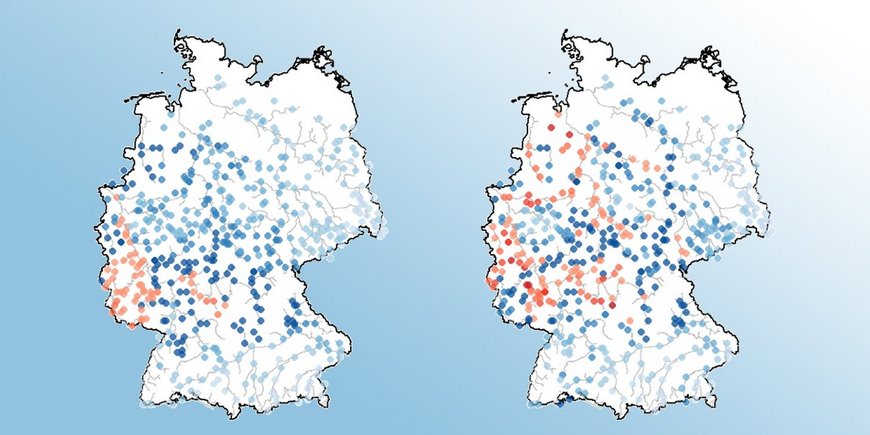Summary
Floods affect more people worldwide than any other natural hazard, causing enormous damage that is expected to increase in a warming world. However, people and decision-makers in vulnerable regions are often unwilling to prepare for exceptionally severe events because they are difficult to imagine and beyond their experience. In a recent study, a team of researchers led by Bruno Merz and Sergiy Vorogushyn from the GFZ German Research Centre for Geosciences proposes a new strategy to motivate society to discuss appropriate risk management strategies: They are developing a series of hypothetical extreme flooding scenarios in Germany by shifting previously observed precipitation events by a few tens of kilometres in space and then calculating their effects using a flood model. Such scenarios are not improbable, as the actual precipitation could have fallen several dozen kilometres away. This results in events that are more than twice as severe as the most devastating flood in Germany since 1950. It also shows that regions spared in the past cannot feel safe, as they could also have been hit hard by destruction. The results were published in the journal Environmental Research Letters.
Background: Not well prepared for extraordinary events
Flooding affects more people globally than any other natural hazard. The July 2021 floods in Western Europe alone caused more than 220 fatalities and damage totalling almost EUR 50 billion. Despite tremendous impacts of exceptional floods in recent decades and their predicted, more frequent occurrence in the future, society is often unwilling to discuss and prepare for such events.
Surveys have shown that people find it difficult to empathise with events that they have not experienced themselves: They are then not good at predicting the negative effects of severe flooding. And they tend to judge the likelihood of an event by how easily they can imagine it. In addition, people and organisations generally find it difficult to think about threatening prospects and feel uncomfortable planning for situations that would harm themselves.
As a result, society is often surprised and little prepared when events occur that are more serious than what they have previously experienced – with catastrophic consequences1. “The lack of preparedness to think about and prepare for exceptional flooding is worrying, as exceptional events are expected to occur more frequently in a warmer world. Hence, there is a need to develop exceptional scenarios which can also be understood by non-experts,” says Bruno Merz, Head of the Hydrology Section at the GFZ German Research Centre for Geosciences in Potsdam and Professor of Hydrology at the University of Potsdam.
New approach: virtual spatial displacement of past extreme events
The severity of an event is often described in terms of return periods, such as the 100-year or 1000-year flood. This expresses the fact that an event of this severity only occurs on average every 100 or 1000 years. The probability of this occurring in a given year is therefore 1:100 or 1:1000. However, this concept is not easily accessible to laypeople.
Instead, the research team led by Bruno Merz and Sergiy Vorogushyn, senior scientist in the GFZ Hydrology Section, proposes using alternative spatial scenarios. These so-called counterfactual scenarios are alternative possibilities for past events, i.e. scenarios that did not occur but could have happened. To develop them, the researchers shift the precipitation fields of past floods and simulate the consequences that would have resulted if the paths of the low-pressure areas that caused them had taken a different route.
“We assume that it is easy for even laypeople to understand that a low-pressure system that caused heavy rain in a certain region could have developed slightly differently. As a result, a region that was spared at the time could have been hit and an affected region could have been hit much harder – so they were just lucky at the time,” explains Merz.
For their study, the researchers selected the ten most damaging floods in Germany since 1950 and shifted the rainfall at that time to three distances – 20, 50 and 100 kilometres – and eight directions. Such shifts are well justified in view of the mechanisms involved: The paths of precipitation-forming low-pressure systems are dominated by non-linear interactions on scales of ∼1,000 kilometres or more. Therefore, the precipitation fields of individual events can also develop differently if the overall meteorological situation is slightly different. These 24 counterfactual precipitation events for each of the ten largest disasters were fed into a flood model in order to quantify the severity of the flood for the corresponding regions in Germany.
Results using the example of the Christmas flood of 1993
It turned out that the shift in precipitation can lead to much more severe flooding than the actual event. The Christmas floods of 1993 serve as an example:
Widespread and partially extreme precipitation in December 1993 led to flooding along the Middle and Lower Rhine at Christmas 1993, leading to several fatalities and inundations in three federal states. In Cologne alone, more than 13,500 households were affected. A counterfactual flood results here from a shift in the precipitation field by 50 kilometres towards the north-east. If the rain would have fallen there, many of the flood-hit locations would have been affected harder. And, in addition, many locations that have been spared from havoc would have been hit by river water levels surpassing flood defences.
Areas in the Weser river basin, that was only mildly affected in 1993, for example, would have experienced floods greater than the 100-year flood. Overall, the counterfactual scenarios generate peak discharges at more than 70 per cent of the 516 river gauges across Germany considered in this study that exceed the record floods currently recorded there.
Outlook: Utilising counterfactual scenarios for risk management
“Given that risk management tends to focus on the largest observed floods, the ease with which our approach generates many new flood-of-records is disturbing,” summarises Merz.
“Our new approach is able to generate plausible exceptional scenarios that could be used to communicate flood risk to lay people and support flood risk management. Although damages cannot completely be prevented when exceptional floods occur, risk management can limit disastrous impacts,” adds Sergiy Vorogushyn.
For example, forecasting, early warning and evacuation schemes can prevent fatalities. Spatial planning and infrastructure management can ensure that sensitive infrastructure such as care homes for the elderly and critical infrastructure such as power stations are either not located in hazardous zones or are protected against inundation.
In addition, infrastructure management can design backup and redundancy measures for continuous operation during inundation and develop measures that enable a rapid return to minimum service levels if a failure cannot be prevented.
Original publication
Bruno Merz, et al Spatial counterfactuals to explore disastrous flooding 2024 Environ. Res. Lett.19 044022, DOI: 10.1088/1748-9326/ad22b9
https://iopscience.iop.org/article/10.1088/1748-9326/ad22b9
1Kreibich, H., et al (2022): The challenge of unprecedented floods and droughts in risk management. - Nature, 608, 80-86. DOI: 10.1038/s41586-022-04917-5
https://doi.org/10.1038/s41586-022-04917-5













![[Translate to English:] [Translate to English:] Abror Gafurov von dem Schriftzug "Welcome to Azerbaijan" und den UN und COP Logos](/fileadmin/_processed_/2/5/csm_2024_11_Baku_COP29_Abror_Gafurov_1042faec82.jpeg)


![[Translate to English:] Martin Herold standing in front of the library on the Telegrafenberg](/fileadmin/_processed_/c/d/csm_Martin_Herold_d385ee4dd9.jpeg)
![[Translate to English:] Many people are listening to a presentation in the GFZ lecture hall.](/fileadmin/_processed_/c/a/csm_1_Bild1_hell_b9c0e9f5ed.jpeg)






![[Translate to English:] Both scientists sitting on stools in front of a wall of books in the Telegrafenberg library](/fileadmin/_processed_/6/6/csm_Buiter_Castell_DORA_4_e87cb1ea18.jpeg)
![[Translate to English:] Gruppenbild mit 4 Personen](/fileadmin/_processed_/8/d/csm_20241017_GFZ-Emmerman-Medal-005_web_reinhardtundsommer_21a414fa4a.jpeg)






![[Translate to English:] Ice landscape with five red tents](/fileadmin/_processed_/8/9/csm_Zeltlager_auf_dem_Eis_Urheberin_Jenine_McCutcheon_5ced2d523b.jpeg)





